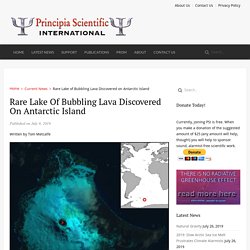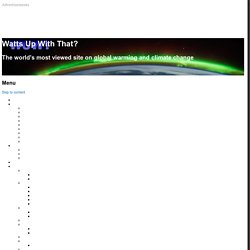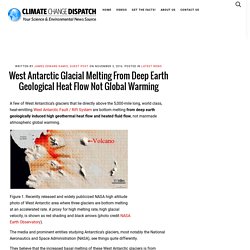

-New heat flow map of Antarctica based on revised data sets. For... Rare Lake of Bubbling Lava Discovered on Antarctic Island. Published on July 9, 2019 Written by Tom Metcalfe.

Geological 'Hotspot' Melting Pine Island,Thwaites Glaciers, Not Global Warming. Published on February 26, 2019 Written by James Edward Kamis Rapid melting of Antarctica’s Pine Island and Thwaites Glaciers is the result of subglacial bedrock heat flow from a well-known and precisely mapped regional geological “hotspot” called the Marie Byrd Mantle Plume, not global warming.

Mantle Plumes are gigantic deep-earth, mushroom-shaped pods of hot molten lava. The mushroom stem portion of a mantle plume extends downward 1,800 miles to the boundary between Earth’s lower mantle and outer core layers. Here, the mantle plume stem taps into massive stores of molten lava which it circulates upward and onto the base of shallow rock layers near earth’s surface. Panic time: a tiny 0.01% of Antarctica, resting on volcanoes, melts five times faster than nothing.
South Pole: Rock 'hotspot' causes ice sheet to sag. Image copyright TOM JORDAN.

High Heat Measured under Antarctica Could Support Substantial Life. Temperatures on the West Antarctic Ice Sheet can plummet below –50 degrees Celsius in winter.

But under the ice scientists have found intense geothermal heat seeping up from Earth’s interior. The heat production that they measured is nearly four times the global average—“higher than 99 percent of all the measurements made on continents around the world,” says Andrew Fisher, a hydrogeologist at the University of California, Santa Cruz, who worked on the project. Hydrothermal vents discovered off Antarctica. Scientists at Columbia's Lamont-Doherty Earth Observatory have found evidence of hydrothermal vents on the seafloor near Antarctica, formerly a blank spot on the map for researchers wanting to learn more about seafloor formation and the bizarre life forms drawn to these extreme environments.

Hydrothermal vents spew volcanically heated seawater from the planet's underwater mountain ranges -- the vast mid-ocean ridge system, where lava erupts and new crust forms. Chemicals dissolved in those vents influence ocean chemistry and sustain a complex web of organisms, much as sunlight does on land. In recent decades more than 220 vents have been discovered worldwide, but so far no one has looked for them in the rough and frigid waters off Antarctica. Hot News from the Antarctic Underground. Claim: Gravity data show that Antarctic ice sheet is melting increasingly faster – but never mind the active volcanic region under the ice. The map from that article- compare to the one below it, while not exactly the same location, perhaps there is another volcanic process nearby?

There is other support for that idea: Volcanic heat source discovered under Pine Island Glacier, the poster child for Antarctic melting. 3 New Studies: Volcanoes, Not Global Warming, Melting West Antarctic Glaciers. What an Engineer Finds Amazing About the Claims of Arctic and Antarctic Melting. West Antarctic Volcano and Fault Belt Part of 'Pacific Ring of Fire' The first physical evidence of subglacial volcanism under the West Antarctic Ice Sheet.
New map of Antarctic geothermal heat suggests Steig & Mann 2009 weren’t measuring ‘global warming’ This is quite interesting.

Remember the claim in on the front cover of Nature in 2009 by Steig and Mann that Antarctica was warming, thanks to that “special Mannian PCA math sauce” that was applied to air temperature data to smear surface temperature trends over the entire continent? It was dashed by climate skeptics who wrote a paper. It was accepted for publication and disproved (in my opinion) by a team of credible skeptics that wrote a counter-paper. But, there’s an interesting twist thanks to new and surprising data; Steig and Mann may have captured surface air temperature trends in the exact same areas that have been identified as geothermal hot spots.
Skeptic paper on Antarctica accepted – rebuts Steig et al. In a blow to the Real Climate “hockey team” one team member’s paper, Steig et al Nature, Jan 22, 2009 (seen at left) has been shown lacking.

Once appropriate statistical procedures were applied, the real data spoke clearly, and it was done in a peer reviewed paper by skeptics. Jeff Condon of the Air Vent writes via email that he and co-authors, Ryan O’Donnell, Nicholas Lewis, and Steve McIntyre have succeeded in getting a paper accepted into the prestigious Journal of Climate and asked me to re-post the notice here. The review process was difficult, with one reviewer getting difficult on submitted comments [and subsequent rebuttal comments from authors ] that became longer than the submitted paper, 88 pages, 10 times the length of the paper they submitted!
I commend them for their patience in wading through such formidable bloviation. West Antarctic Glacial Melting From Deep Earth Geological Heat Flow Not Global Warming. A few of West Antarctica’s glaciers that lie directly above the 5,000-mile long, world class, heat-emitting West Antarctic Fault / Rift System are bottom melting from deep earth geologically induced high geothermal heat flow and heated fluid flow, not manmade atmospheric global warming.

Figure 1. Recently released and widely publicized NASA high altitude photo of West Antarctic area where three glaciers are bottom melting at an accelerated rate. A proxy for high melting rate, high glacial velocity, is shown as red shading and black arrows (photo credit NASA Earth Observatory). The media and prominent entities studying Antarctica’s glaciers, most notably the National Aeronautics and Space Administration (NASA), see things quite differently.
Researcher ‘has a problem’ with attributing West Antarctic Ice Sheet ‘collapse’ to human activity. From NASA JPL and Lamont-Doherty Earth Observatory, something that maybe journo-hacktivist Susanne Goldenberg should pay attention to before she writes another screed.

Reports that a portion of the West Antarctic Ice Sheet has begun to irretrievably collapse, threatening a 4-foot rise in sea levels over the next couple of centuries, surged through the news media last week. But many are asking if even this dramatic news will alter the policy conversation over what to do about climate change. Glaciers like the ones that were the focus of two new studies move at, well, a glacial pace. Researchers are used to contemplating changes that happen over many thousands of years. This time, however, we’re talking hundreds of years, perhaps — something that can be understood in comparison to recent history, a timescale of several human generations.
Researchers discover volcanic activity is changing Antarctica’s geology. On January 10, 2016, amid a flurry of worldwide media fanfare, a team of 44 scientists from Australia’s Antarctic Division set sail from Hobart Australia headed for the Kerguelen Plateau (figure 1) located off the coast of Antarctica on what was billed as a Global Warming / Climate Change Research Project (Antarctic Scientists head to Biological Hotspot studying climate change in Southern Ocean).
Figure 1: Map showing the location of the Kerguelen Plateau, Kerguelen Islands, and Heard Island (Supplied: AAD). This Plateau is approximately 600 miles north of Antarctica. The research premise was that man-made global warming was heating the ocean regions in the Kerguelen Plateau region and hurting seals, whales, birds, and worst of all, melting sea ice.
Study finds surprisingly high geothermal heating beneath West Antarctic Ice Sheet. In Latest West Antarctic Glacial Melt Scare, Influence of Geological Heat Flow Ignored. NASA: volcanic magma plume under Antarctica may explain ice sheet instability. Study bolsters theory of heat source under Antarctica. A new NASA study adds evidence that a geothermal heat source called a mantle plume lies deep below Antarctica's Marie Byrd Land, explaining some of the melting that creates lakes and rivers under the ice sheet. Although the heat source isn't a new or increasing threat to the West Antarctic ice sheet, it may help explain why the ice sheet collapsed rapidly in an earlier era of rapid climate change, and why it is so unstable today. The stability of an ice sheet is closely related to how much water lubricates it from below, allowing glaciers to slide more easily.
Underwater volcanoes heating Antarctic waters. 11 Jul 2011 - Scientists from the British Antarctic Survey (BAS) have discovered previously unknown volcanoes in the ocean waters around the remote South Sandwich Islands. Using ship-borne sea-floor mapping technology during research cruises onboard the RRS James Clark Ross, the scientists found 12 volcanoes beneath the sea surface — some up to 3km (1.86 miles) high. They found 5km (3 mile) diameter craters left by collapsing volcanoes and 7 active volcanoes visible above the sea as a chain of islands. Evidence of Recent Volcanic Eruptions Under the Western Antarctic Ice Sheet.